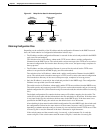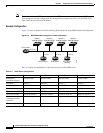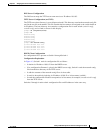
CHAPTER
5-1
Catalyst 2950 Desktop Switch Software Configuration Guide
78-11380-05
5
Configuring IE2100 CNS Agents
This chapter describes how to configure the Intelligence Engine 2100 (IE2100) Series Cisco Networking
Services (CNS) embedded agents on your switch. To use the feature described in this chapter, you must
have the enhanced software image (EI) installed on your switch.
Note For complete syntax and usage information for the commands used in this section, refer to the Cisco
Intelligence Engine 2100 Series Configuration Registrar Manual, and select Cisco IOS Software
Release 12.2 > New Feature Documentation > 12.2(2)T on Cisco.com.
This chapter consists of these sections:
• Understanding IE2100 Series Configuration Registrar Software, page 5-1
• Understanding CNS Embedded Agents, page 5-5
• Configuring CNS Embedded Agents, page 5-6
• Displaying CNS Configuration, page 5-12
Understanding IE2100 Series Configuration Registrar Software
The IE2100 Series Configuration Registrar is a network management device that acts as a configuration
service for automating the deployment and management of network devices and services
(see Figure 5-1). Each Configuration Registrar manages a group of Cisco IOS devices (switches and
routers) and the services that they deliver, storing their configurations and delivering them as needed.
The Configuration Registrar automates initial configurations and configuration updates by generating
device-specific configuration changes, sending them to the device, executing the configuration change,
and logging the results.
The Configuration Registrar supports standalone and server modes and has these CNS components:
• Configuration service (web server, file manager, and namespace mapping server)
• Event service (event gateway)
• Data service directory (data models and schema)
In standalone mode, the Configuration Registrar supports an embedded CNS Directory Service. In this
mode, no external directory or other data store is required. In server mode, the Configuration Registrar
supports the use of a user-defined external directory.


















